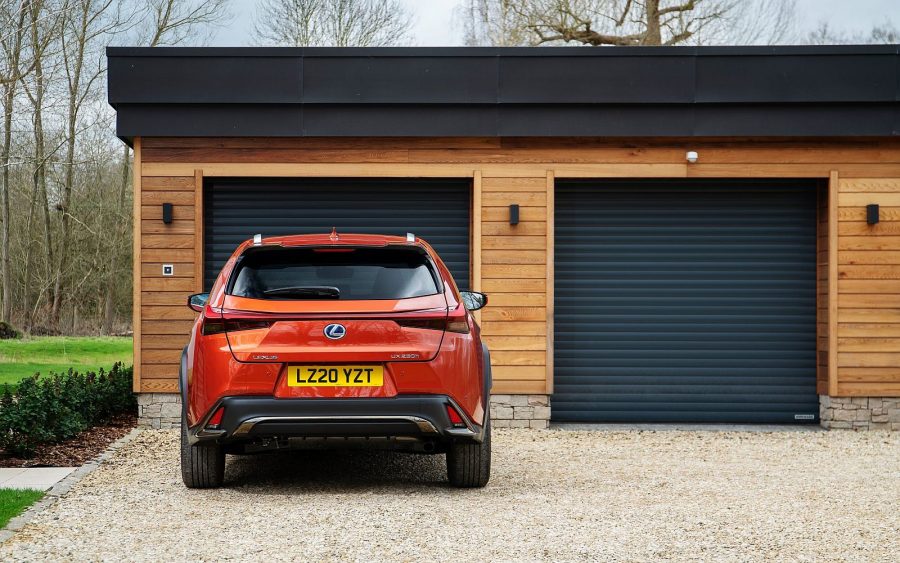According to the Office for National Statistics (ONS), cases of vehicle-related crimes in England and Wales have significantly declined over the past few decades. While this is comforting news for car owners and a broad recognition of the improved security measures included as standard in new vehicles, we should remember that car thieves have not stopped operating.
It is therefore important not to become casual about vehicle security and run the risk of becoming a statistic ourselves. With that in mind, the following seven points are our top recommendations for improving car security.

1. Lock your car
This advice may seem obvious but ONS crime figures show that car owners consistently forget to apply this most basic security feature. Almost half of all vehicle-related thefts are because thieves had gained access through an unlocked door.
Get in the habit of always locking up, even if you will only be away from the car for a few seconds. Don’t solely rely on a quick press of the key fob either: check for audible or visual signals that the car has actually locked before you walk away. And if your Lexus has door mirrors that can automatically fold in when the car is locked, be sure to activate this feature – potential thieves recognise it is a clear visual sign of a locked car.
2. Keep valuables out of sight
Opportunist thieves are often looking for easy-to-grab valuables that have been left on display. Police report that items such as jewellery, bags, purses and wallets, cash, credit cards, clothes and documents are the most commonly stolen in vehicle-related crimes.
Reduce this risk by stashing valuables out of sight, such as in the glove box or boot. Better still, take those items away with you. And if you’re going to leave the car for a longer period of time, consider clearing the boot entirely and removing the parcel shelf or load cover to show thieves that there is nothing to steal.

3. Be mindful of signals
Most modern Lexus models are equipped with a keyless entry and start system – a convenience which sends a constant signal from the key fob in order to unlock the vehicle’s doors and de-activate the immobiliser as you approach. Although it is possible for tech-savvy thieves with special equipment to hijack this signal, they must be in close proximity to the key or vehicle.
So if you doubt the intentions of anybody in the immediate vicinity of your vehicle, wait for them to leave before approaching the car. Better still, whenever you are not driving, block the signal from the key by keeping it in a metal box or Faraday pouch. This is equally important at home as thieves can use a ‘daisy chain’ of receivers to relay the signal from the key (which is probably kept near the front door) to open the car.
4. Secure your port
Every new car sold in the UK since 2003 has been equipped with an on-board diagnostic port. Abbreviated to OBD, this port is a computer connection that allows the car to communicate messages about its mechanical health to an authorised technician. Unfortunately, thieves have discovered that with special equipment they can use this OBD port to programme blank keys to work with the car.
For this reason, some owners choose to secure their OBD port with an aftermarket lock. Typically, this can either be a lockable metal box that covers the port itself, or an electronic lock that works alongside the original immobiliser to disable the port when the ignition is off.

5. Protect your cat
Your catalytic converter, that is. The ‘cat’ forms part of your car’s emissions control system and cleans exhaust gases before they are expelled through the tailpipe. Unfortunately, the precious metals inside the cat that help to neutralise these passing gases are exactly that – precious. Which means that the catalytic converter itself has become a target for thieves.
Some owners have taken action to deter thieves by invisibly marking their catalytic converter with a forensic marking fluid, such as that provided by SmartWater. Mechanical theft prevention products such as Catloc devices can also deter thieves. These measures are explained in more detail in our dedicated article on catalytic converter theft.
6. Park with care
Thieves do not like performing in front of an audience, so the place where you park has a bearing on the vehicle’s vulnerability. ONS statistics show that the likelihood of experiencing a car-related crime is much lower in busy, town centre parking areas. This is especially true when car parks are well-lit and have manned or CCTV security coverage.
Similarly, the time at which you park your car has a bearing on its security. Most instances of car-related crimes occur in the early hours of the morning, so avoid leaving in your car in a dark, unfamiliar area overnight.

7. Extra security
Modern vehicles invariably come with a high level of built-in security – the specific features of which are usually designed to react in the event of an incident. But there are simple things you can do to actively dissuade a thief from pursuing an attack on your car. These measures include:
- The use of a brightly coloured mechanical device locked across the steering wheel, gear lever or clutch pedal will provide an excellent visual deterrent to a would-be thief.
- We may be living in a digital age but nothing will persuade an opportunist to leave your car alone more effectively than a good old-fashioned piece of ironmongery. Or for that matter, a snarling dog.
More information on preventing car crime can be found by visiting the Police UK website – www.police.uk – and by searching ‘car crime’.





Hi Lexus team,
I have a Lexus IS 300h 2020. Is is susceptible to CAN bus attacks, and what does Lexus offer to fix the security vulnerabilities?
Thank you
Hi there, thanks for your comment.
We will need your full registration number to confirm this.
Thanks,
Hi
I have a 2016 CT200H. Will the car start if the key is not inside the vehicle in a CANbus theft?
Hello,
Please provide your vehicle registration so we can assist you further.
Thank you.
i have just ordered a UX design tech can you tell me when i can expect delivery ?
also on the topic of security which steering wheel lock does lexus recommend for the UX ?
thanks
Hello Danny,
Thanks for your comment.
Your nearest Lexus Centre would be best placed to advise on the ETA of your order.
Furthermore, there isn’t a specific steering wheel lock that we recommend. Although something brighter in colour would act as more of a visual deterrent.
We hope this helps.
Thank you.
I just had a thief try to attempt to steal my NX300h they pulled away at the passenger side bumper to access some controls causing a lot of damage. They removed my tracker dongle and tried to start the car 2 twice but failed. I had the police around and they said they have had lots of my type of car being stolen.
My Q : Lexus why did you not advise customers of the problem with their car and provide security options to prevent the heart ache of losing our prize possessions.
Yes I have the millenco steering lock, but me as a Lexus owner I want more and as we pay premium for our vehicles I expect more from you like locking gear levers with locks, foot pedal locks with keys. and guards for all access points that make the car valuable. If I could put an anchor on my car I’d do it to pee off the thieves. So Lexus talk to us work together with us to put a stop to the madness of car theft
Hello Brian,
We are terribly sorry to hear that you have been affected by this horrible crime
Please be assured with measures such as this article, we have been trying our absolute best to ensure all of our customers are aware.
If you reply to this comment with your vehicle registration, we can advise what security enhancements are available to you.
We’ll censor your registration before publishing your reply.
Thank you.
Hello Lexus Team
I am in the process of purchasing an ES300h (BF73***). Having read various comments in this post and others, can you please confirm if this model at risk of the CANbus vulnerability?
Thanks.
David
Good afternoon David,
Please get in touch with your local Lexus Centre to find out what additional security measures are available for the car.
To find details of your closest Centre, visit: https://brnw.ch/21wR5IG
Thank you.
I had my Lexus and 300H stolen in August it was recovered and I personally paid to have all the damage repaired. The car was stolen again last night. The police have recovered the echo me today with the steering wheel cut in 2 places to get past to recover the steering lock. The whelk arch and headlight are damaged the light controls panel has been ripped from the roof. The Ghieves have torn apart the boot trying to find the tracker and crashed the front passenger wheel. The display states that the hubrid system is not working and to go to the dealer. I bought a Lexus because of their reliability and my wish to avoid stress. It’s Sunday early evening my insurance company is closed I fly on a 30 day Buisness trip tomorrow . This is stress I could do without. I am more than disappointed with Lexus response to the issue that allows thieves to steal a car so easily.
Hi John,
We are very sorry to hear that you have been a victim of this crime and for the distress and inconvenience this has caused.
Please be assured this is a matter that we are taking extremely seriously.
We are continuously developing technical solutions to make our vehicles more secure and reduce the risk of theft.
While we understand theft or attempted theft can be highly upsetting and, in some cases, a costly experience, in such instances customers are first and foremost victims of crime.
Lexus does not cover costs associated with criminal activity either under the terms of the warranty or as goodwill.
Once again, we are really sorry that you have been affected by this horrible crime and for the distress this has caused.
Thank you.
I have a 2019 NX300h i would like to know if this is vulnerable to the Can Bus attack or the attack accessing the wiring loom via the passenger wheel well.
I realise that the car is already vulnerable to relay theft but would like to know if lexus offer replacement keys without the continuous signal option.
Thanks Pete
Hi Pete,
Please provide your full vehicle registration so we can advise further.
Thank you.
Hi
Can I confirm my NX450H+ 23 plate doesn’t have the CANbus issue
Thanks
Good morning,
Please advise your full registration so we can advise further.
Thank you.
What are Lexus doing about the CANBUS issue, someone has tried to steal my car for the second time after having the protection plates fitted (not fit for purpose, thieves now cut through them, as this is how they stole my sisters RX450H F-Sport), as I now have to pay out just under £10,000 to have the wire replaced because they cut through this! After my sisters car was stolen I had a Ghost II Immobiliser fitted. In the images of stolen cars found in the media, the majority of them are Lexus’s and even found a picture of my sisters stolen car, recovered 3 months after it was stolen. I’m glad to say that she no longer trusts the Lexus brand and feels sorry for anyone driving a 21 plate as it will only be a matter of time before its stolen.
We are very sorry to hear that you have been a victim of this crime and for the distress and inconvenience this has caused.
Please be assured this is a matter that we are taking extremely seriously.
We are continuously developing technical solutions to make our vehicles more secure and reduce the risk of theft.
While we understand theft or attempted theft can be highly upsetting and, in some cases, a costly experience, in such instances customers are first and foremost victims of crime.
Once again, we are really sorry that you have been affected by this horrible crime and for the distress this has caused.
Thank you.
I can confirm that the 23 plate NX450+ with the security fixes is susceptible to CanBus theft.
My vehicle was parked against a wall so the wheel arch was not accessible, they interfered with the “Adaptive High Beam Assist” as reported by the car , neighbours CCTV shows them only at the front of the car by the front grill. They then cut through the steering wheel in 2 places and removed steering lock. Start to finish 1 min 20 sec`s and car gone , mine was one of two that night in immediate area.
Interesting that a simple wire that runs down the middle of the centre console for the DCM – Digital Communication Module , once cut or pulled out then the car can no longer communicate to the outside world. , exceptional design from “master craftsman” words used by sales person when purchasing.
Had the last laugh as Lexus sold me a return to invoice GAP , which is no longer available due to volume of Lexus being stolen.
Registration was EK23***
I appreciate you cannot stop all car thefts as they adapt but do not make it as easy for them , if the last report from the car was help i am being interfered with shut it down.
Hi Stephen,
We are very sorry to hear that you have been a victim of this crime and for the distress and inconvenience this has caused.
Please be assured this is a matter that we are taking extremely seriously.
We are continuously developing technical solutions to make our vehicles more secure and reduce the risk of theft.
While we understand theft or attempted theft can be highly upsetting and, in some cases, a costly experience, in such instances customers are first and foremost victims of crime.
Lexus does not cover costs associated with criminal activity either under the terms of the warranty or as goodwill.
Once again, we are really sorry that you have been affected by this horrible crime and for the distress this has caused.
Thank you.
Many thanks for reply
I was NOT after Lexus covering associated costs , i was one of the lucky people that you sold a “return to invoice GAP insurance Policy” which has since been stopped due to the High volume of thefts.
This vehicle was probable the best and most comfortable car i have had to date but would appear is let down by your Design / Engineering team , why are access points to critical systems located in place where any body can access.
In my instance if the headlight Can Bus connection was on the inside of the engine compartment instead of the wheel arch / bulkhead then it would have been potected by the bonnet area.
A simple wire change for the “DCM – Digital Communication Module” would also stop them disabling the remote monitoring / tracker at present it is run in the centre console.
Further reports locally now indicate thet are also cutting a hole above the NX450h+ logo on the tailgate and accessing the CanBus from here.
Total redesign require i think
Hello Stephen,
Thank you for your reply.
Please be reassured that Lexus is committed to continue our urgent focus on vehicle crime; how we can better support the police and other authorities in their attempts to tackle this industry wide issue, but also to support existing and new customers by supplying a variety of solutions to deter theft and help recover stolen vehicles.
Apologies again for the distress caused by the theft of your Lexus.
Many thanks,
Lexus UK
Canbus Protection Plates may be available but they are now cutting holes by rear number plates and accessing from here.
See http://www.lexusownersclub.co.uk/forum , here you will see the true scale of how easily a Lexus is stolen.